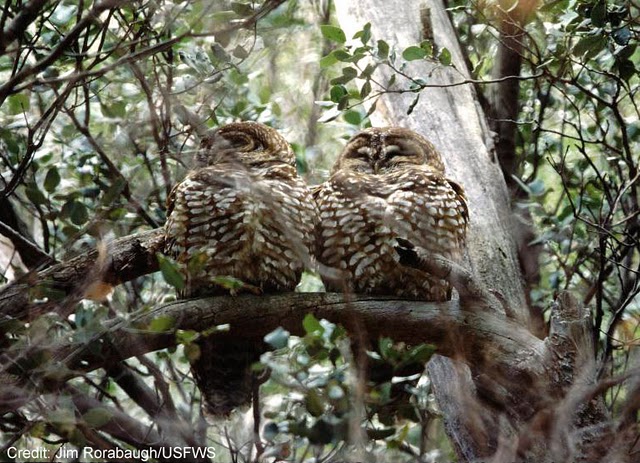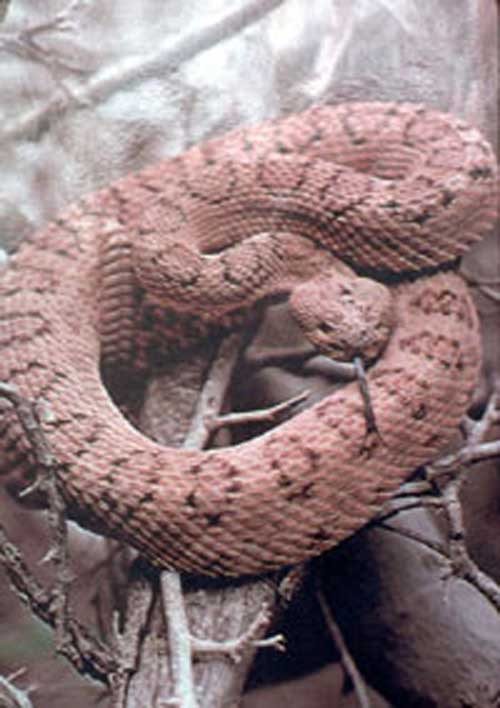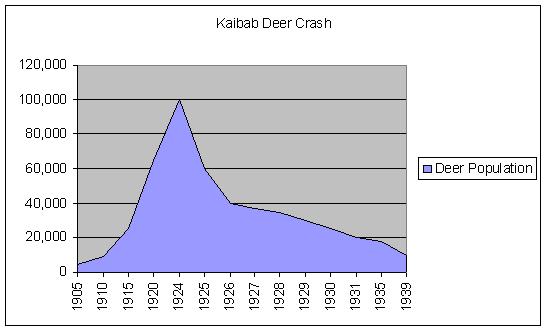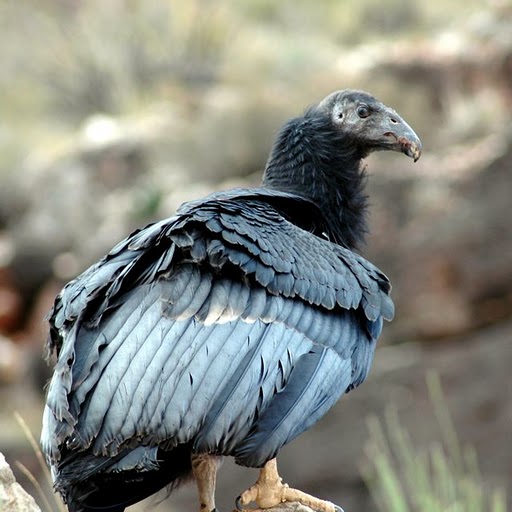Wildlife has always been an important element of the Grand Canyon environment and a significant draw for tourists. In 1906 President Theodore Roosevelt declared a portion of today’s park the Grand Canyon Game Preserve. This designation was meant to help protect wildlife, partly as precious components of the natural environment but also so that hunters could count on having big prey to pursue in the future. The conflict over which wildlife to preserve and which to discourage or remove has created division among NPS personnel, environmentalists, local residents, and everyday visitors to the Canyon even into the present day.
For nearly a century now, the NPS has worked to advance the general knowledge of flora and fauna in the park, conducting research into all aspects of animals’ lives as well as their impact on the environment and the impact of human presence on them. Beginning in 1919, they consistently initiated, accompanied, or assisted scientific investigations undertaken by outside agencies. Early chief naturalists Glenn Sturdevant, Edwin McKee, and Louis Shellbach along with botanist Rose Collem, spent considerable time compiling checklists of geologic features, flora, birds, reptiles, amphibians, and mammals, establishing baseline lists of species and uncovering rare and endangered species worthy of attention.
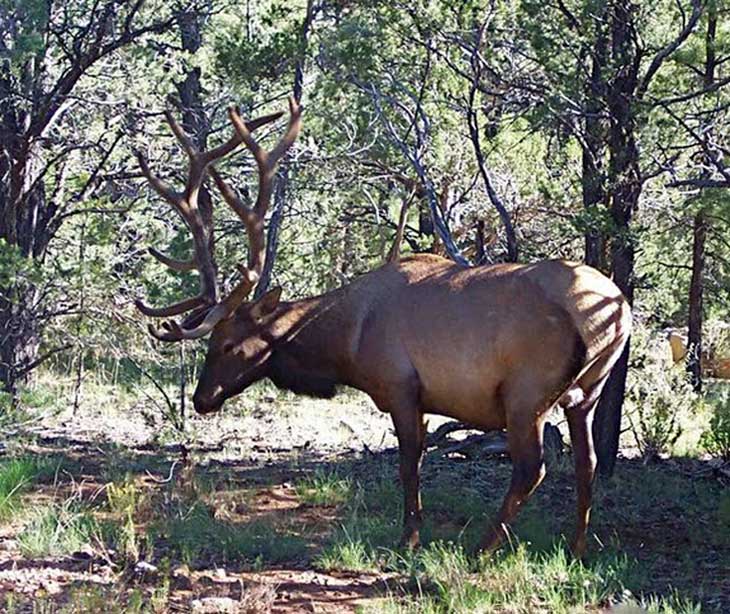
Elk are one of the most sought-after game animals for hunters and were of particular interest to president Theodore Roosevelt when he established national wildlife refuges. Elk were extirpated from the Grand Canyon region by hunters during the pioneer era, but reintroduced to northern Arizona in the 1930s.
Photo: Michael Anderson
Today, wildlife biologists continue research, education, and management projects designed to increase knowledge, appreciation, and conservation of Grand Canyon’s wildlife communities.
According to the NPS, more than 373 bird, 89 mammal, 47 reptile, 9 amphibian, and 17 fish species live in the park. Through the work of rangers and scientists, the public can now learn about a variety of wildlife that call the Canyon home, including rare, endangered, and unique species not found anywhere else.
Many birds are attracted to the richly vegetated riparian zones of the Canyon where water flows either seasonally or year-round. About 250 of the 373 bird species in the Grand Canyon region are found along the Colorado River corridor, although most of them only use the area during migration or winter habitat. Abundant trout attract eagles to the Colorado River, while the calm waters of Lake Powell behind Glen Canyon Dam attract migrating ducks in winter months. In desert areas, peregrine falcons can be found feasting on bats, swifts, and other birds while nesting along the cliffs of the inner canyon.
Many birds reside in the coniferous forests along the rims, including goshawks and spotted owls that are threatened species in the Southwest because of historic and contemporary logging.
Mammals at the Grand Canyon range from tiny rodents to large bears. The most common mammals that live along the Colorado River corridor are rodents and bats. Within the past few decades, river otters and muskrats have become extremely rare. But since the completion of Glen Canyon Dam beavers have begun reappearing in the park. Coniferous forests provide habitat for the most mammal species, including porcupines, several species of squirrels, black bear, mule deer, and elk. Mammals such as bighorn sheep, coyotes, ringtail cats, skunks, raccoons, bobcats, foxes and cougars range widely throughout the park.
One of the more unique wildlife stories involving the Grand Canyon is that of the Kaibab and Abert squirrels. While both of these species of squirrels have tasseled ears, the Abert squirrel lives in the forests on the south rim of the Canyon and throughout the Colorado Plateau and has gray coloring with a white underbelly, while the Kaibab squirrel is found only in the ponderosa pine forests on the North Rim’s Kaibab Plateau and has a black belly and white tail. Though these populations were once the same, the formation of the Canyon several million years ago created a barrier that isolated the two populations from each other until today, the Kaibab squirrel is recognized as a unique species. In large part because of the Kaibab squirrel, the National Park Service and US Forest Service collaborated to designate a large portion of the Kaibab Plateau as a National Natural Landmark. You can learn about this program at: http://www.nature.nps.gov/nnl/
The nearly four dozen reptile species that roam the park live in a wide range of habitats. Snakes, lizards, geckos, tortoises, gila monsters, and chuckwallas all make the Canyon home. The Grand Canyon pink rattlesnake is probably the most celebrated rattlesnake in the park; a subspecies of the Western Diamondback, it is found only at the Grand Canyon. Amphibians such as frogs, toads, and salamanders live mostly in the riparian communities along the Colorado River and its tributaries, though some species also live in the coniferous forests along the rim. The Canyon is also home to a variety of insects, spiders, scorpions, and other invertebrates.
The fish in the Colorado River within the Grand Canyon are today a mix of native and introduced species. At the turn of the century wildlife managers tried to introduce sport fish such as trout, bass, and catfish into the Colorado, but most did not survive long until the completion of the Glen Canyon Dam in 1963.
Although the NPS stopped stocking fish after this, the Arizona Game and Fish Department continued planting rainbow trout until the 1990s. Until the mid-60s, eight native fish species thrived in the Colorado River through the Grand Canyon. Over many millennia these fish had adapted to the dramatic fluctuations in river flow, temperature, and sediment. Of these eight native fish species, only three are doing well. Three other species have completely disappeared, while two are on the federal endangered species list. Introduced fish compete with native fish for habitat and food, and sometimes even prey on them. Since 1958, twenty-four species of non-native fish have been found in the Grand Canyon, and at least half of those are still there today, though the number might increase as fish stocked in Lake Mead continue to spread upriver.
Political and social movements have played a major role in shaping the composition of wildlife at the Grand Canyon throughout its history. Over the past two centuries American attitudes about wildlife have evolved considerably. In the 19th century most Americans saw wildlife in utilitarian terms: as a food source (meat), a commodity (fur), a recreation (sport hunting), a pest to eradicate (mice and prairie dogs), or as blood-thirsty carnivores to fear and loathe (bears, wolves, and mountains lions). This perspective shaped behavior and policy as profoundly as it shaped the lives and fortunes of wild animals themselves in the early years of the National Park Service.
By the 1890s growing concerns about our impact on wildlife led to new policies and national initiatives to protect some species and their habitats. The federal government prohibited interstate trade of certain birds threatened with extinction from the hat trade in the 1900 Lacey Act. States adopted or strengthened hunting and fishing regulations.

In 1871, William Henry Jackson captured famous artist Thomas Moran showing off the results of a successful day of fishing in the Colorado River in what is today Grand Canyon National Park. Today many of the fish that Jackson and Moran would have seen in the river have been extirpated by an invasion of non-native fish.
Photo: National Park Service Historic Photograph Collection
Wildlife refuges and fish hatcheries were established all over the country. Still, the predominant attitude of most Americans in the early 20th century was to fear or favor particular wildlife. Not surprisingly, these cultural predilections shaped national park policy. For most of the 20th century, park managers at the Grand Canyon sought to facilitate visitor interactions with favored wildlife (such as deer, elk, and turkeys), while suppressing encounters with feared animals and “varmints” (such as rattlesnakes, bears, and skunks). But these efforts were complicated, their results mixed, and the public reception often ambivalent.
Predator control programs are a good case in point. In the interests of protecting animals pleasing to both tourists and hunters, park rangers joined federal and state game wardens to carry on the Forest Service policy, in effect since 1906, to exterminate four-legged predators—animals “red in tooth and claw” that most Americans considered undesirable. Primary targets included locally abundant mountain lions, bobcats, wolves, and coyotes that fed on deer, antelope, bighorn sheep, and elk, which visitors liked to see and sportsmen liked to hunt.
In the 1920s, however, ecologists began revising their opinions about predators. Rather than mere varmints, ecologists saw predators as crucial components of the web of life and integral to maintaining ecosystem health. The Grand Canyon played an important role in this change in attitude.The Park Service and Forest Service had succeeded in exterminating most predators from the Kaibab Plateau on the north side of the Grand Canyon by the early 1920s. Ironically intended as a measure to protect deer and other favored animals, it instead had disastrous consequences.
With nothing to restrain their numbers, the native Rocky Mountain mule deer population exploded, consumed all the available browse, and then crashed from starvation, with tens of thousands of deer dying. This infamous event recounted by forester and ecologist Aldo Leopold incited a decades-long program to improve ecological conditions on the Kaibab Plateau and balance deer numbers with available browse.
In response to the Kaibab deer crisis, Grand Canyon Superintendent Miner Tillotson modified the predator-control program in 1928, writing that it was no longer NPS policy to exterminate predators but to hunt them “as needed so that serious danger to the more important game animals will be kept to a minimum.” In 1931, Tillotson went further and entirely ended the practice of killing predators in the park.
After this disaster, rather than re-introducing wolves and other predators, though, the federal agencies tried to manage the deer problem through hunting and relocation. While the Park Service had a system-wide policy against hunting and precluded firearms within park bounds, hunting was (and still is) allowed on national forests. So outside the park boundary the Forest Service worked with Arizona game managers to increase deer hunting permits in 1924. Park rangers also participated in annual deer counts while the Forest Service trapped and shipped fawns throughout the West.

Forest Service and early Park Service policy in the Grand Canyon Game Preserve called for genocide on all predator species, most notably the mountain lion. Forest Service North Rim game warden James T. “Uncle Jim” Owens used specially trained hounds to hunt and kill more than 400 mountain lions in the years 1907-1919. The park protects predators today, and wildlife specialists track mountain lions on the South Rim with radio collars to help gauge their ecological needs and impacts. A mountain lion can eat one deer or elk per week, keeping the number of these prey species under control.
Photo: Grand Canyon National Park Museum Collection
Sixty fawns were ferried by truck and air to the South Rim from 1927 through 1931 to lessen the pressure on the North Rim and to provide wildlife entertainment for tourists. Superintendent Tillotson wrote in 1932 that the “friendly little creatures” were great tourist favorites, but stopped smiling when numbers along the South Rim climbed from 120 in 1933 to 550 in 1934. The Park Service had been feeding the deer, but ended that practice in November 1934. Withdrawing the feeding stations had little effect on numbers, and in 1939 administrators began speaking of the Grand Canyon Village “deer problem.” In the early 1940s, rangers again initiated a trap and ship program to “relieve congestion,” removing dozens of semi-tame deer every season from the Village to Desert View. By the early 1950s, Arizona Game & Fish had taken over the effort to transport surplus deer to southern Arizona.
Park rangers also monitored less conspicuous natives like porcupines and beaver, trying trap-and-release methods in the 1930s to relocate the latter away from threatened cottonwood groves along Bright Angel Creek. Working with the U.S. Biological Survey and private funders, they also introduced twelve pronghorn antelope to the Tonto Platform near Hermit Camp in 1925. They had high hopes that these crowd-pleasers would thrive through artificial feeding and restoration of the native flora that earlier livestock had overgrazed. But by 1931, only nineteen were counted and the Park Service began to doubt the project. By 1944, only one remained, at Indian Garden.
Rangers turned then to the propagation of wild turkeys, which had appeared in the Grandview area about the same time. During 1948-50, they released a number of gobblers and thereafter noted an encouraging population increase. The turkeys moved into the Grand Canyon village area providing entertainment for tourists.

When prospectors or tour guides shut down operations, they would often simply release the burros they had used as pack animals out into the wild. They were considered a nuisance in the park, and were hunted into the 1970s, when public sympathy led to a more “humane” program of capture, removal, and adoption.
Photo: BLM
Administrators combined these programs to manipulate the numbers of crowd-pleasing native animals with erratic efforts to address the spread of non-native species, favoring their introduction if they promised to enhance the visitor experience or removing them if they caused obvious biological damage. Not until the 1960s would the NPS settle on a consistent policy of excluding non-native (“exotic”) species.
One of the first targets of this new policy was feral burros, which thrived on the Tonto Platform after their abandonment by pioneer prospectors and tourist operators. They caused a number of severe environmental problems. They denuded range, wore a bewildering array of paths on the Tonto Platform that confused hikers, and accelerated erosion. Park rangers shot more than 1,500 burros during periodic patrols along the Tonto between 1924 and 1933, when Tillotson, believing they were under control, modified policy to one of “partial extermination.” By 1949, another 1,600 had been shot. Hunts persisted into the 1970s, when public sympathy for the charming creatures led to a successful if expensive program of trapping, removal, and adoption.
Eliminating one exotic species that caused extensive environmental damage did not prevent administrators from undertaking an aggressive program to introduce nonnative fish to the canyon’s perennial creeks solely to promote sport fishing. During 1919-1964, rangers obtained more than a million eggs and fry of Loch Leven, Rainbow, Black Spotted, and Eastern Brook Trout from hatcheries at Page Springs, Arizona and Springdale and Richfield, Utah, laboriously packing them in aerated cans on mules down to Roaring Springs, Bright Angel, Wall, Ribbon Falls, Clear, Havasu, Shinumo, and Tapeats Creeks and Thunder River. By 1931, Tillotson wrote that all “favorable trout streams of the Park are now well-stocked.” Thereafter the Park Service annually checked and re-stocked tributaries following major floods that flushed trout to their deaths in the murky Colorado. Rangers also periodically checked food supplies and on at least one occasion planted freshwater shrimp to feed the trout. In winter 1931-32, they installed a field hatchery at Roaring Springs that served Bright Angel Creek and nearby drainages. In 1935, Tillotson bragged that the canyon contained some of the best fly-fishing streams in Arizona, but that they would require “continued re-stocking if we are to meet the fishermen’s demands.” Fish stocking ended in 1964, with the completion of Glen Canyon Dam, but continued for many years above Lees Ferry. Since then, the dam-released, cold, clear river has become an avenue rather than a barrier for exotic trout propagation, and has contributed to the decline of the river’s native fish species.
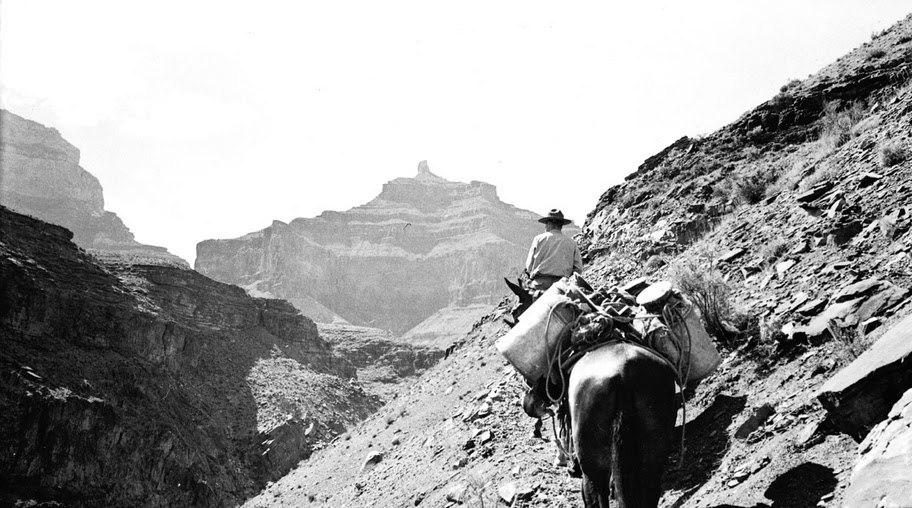
Park administrators began stocking non-native trout in inner-canyon perennial streams in 1919, and continued the practice through 1964, when the release of cold, clear water from Glen Canyon Dam changed the Colorado River from a trout deathtrap to a travel conduit between creeks. Park personnel (in these photos) are transporting and releasing trout fry in Clear Creek circa 1940.
Photo: Grand Canyon National Park Museum Collections
There have been some recent bright spots in the history of wildlife management at the Grand Canyon. One of the greatest successes is the story of the California condor. This condor is the largest land bird in North America and in ancient times roamed across much of the continent, though by 1982 only 22 of the birds remained. The U.S. Fish and Wildlife Service the following year began a captive breeding program to try to restore the numbers of this endangered species, though by 1985 only about nine birds remained in the wild. However, the captive breeding program was successful, and today there are nearly 150 of the birds in captivity plus many more in the wild. Recently, condors began nesting and roosting along the cliffs near Lookout Studio in the Grand Canyon Village, where watchful visitors frequently spot them.
Although for many years park rangers cultivated development of nearly tame wildlife, and though visitors might be tempted to try to feed or pet the animals they see in the park, today federal law makes it illegal to approach or feed wildlife in Grand Canyon National Park. Approaching wildlife may cause stress to them and interfere with their ability to survive in the wild. They are also more likely to be killed by congregating near roadways where humans stop, and might become more aggressive towards humans in trying to snatch away a tasty morsel of food. Although animals might seem tame, they can still behave unpredictably, and visitors to the Grand Canyon are far more likely to be injured by a squirrel, deer, or elk than by a rattlesnake or mountain lion. Watching wildlife from a distance not only protects them—it also protects you, and helps “keep wildlife wild.”

This original oil painting titled Condor Canyon is by UK artist Tell Hicks: http://www.btinternet.com/~tellhicks/pages/prints.htm
Credit: Tell Hicks
Written By Micheal F. Anderson, Paul Hirt, and Sarah Bohl Gerke
References:
- Anderson, Michael F. Living at the Edge: Explorers, Exploiters, and Settlers of the Grand Canyon Region. Grand Canyon Association, 1998.
- Anderson, Michael F. Polishing the Jewel: An Administrative History of Grand Canyon National Park. Grand Canyon Association, 2000.
- Krutch, Joseph Wood. Grand Canyon: Today and All its Yesterdays. New York: Doubleday, 1962.
- Sellars, Richard West. Preserving Nature in the National Parks: A History. New Haven: Yale University Press, 1997.
- Snyder, Noel and Helen Snyder. The California Condor: A Saga of Natural History and Conservation. San Diego: Academic Press, 2000.
- Grand Canyon National Park website on “Animals”: http://www.nps.gov/grca/naturescience/animals.htm


